Jeju’s onggi is fired in a stone kiln instead of an earthen kiln. For thousands of years, the traditional earthenware pots and jars were an integral part of the lives of the residents of the island, where iron is not produced. However, they gradually faded into history after wares mass-produced with synthetic materials emerged in the 1960s. Then, in 2000, after years of painstaking efforts, the traditional stone kiln was rebuilt and production of the island’s indigenous pottery resumed, albeit in small quantities.
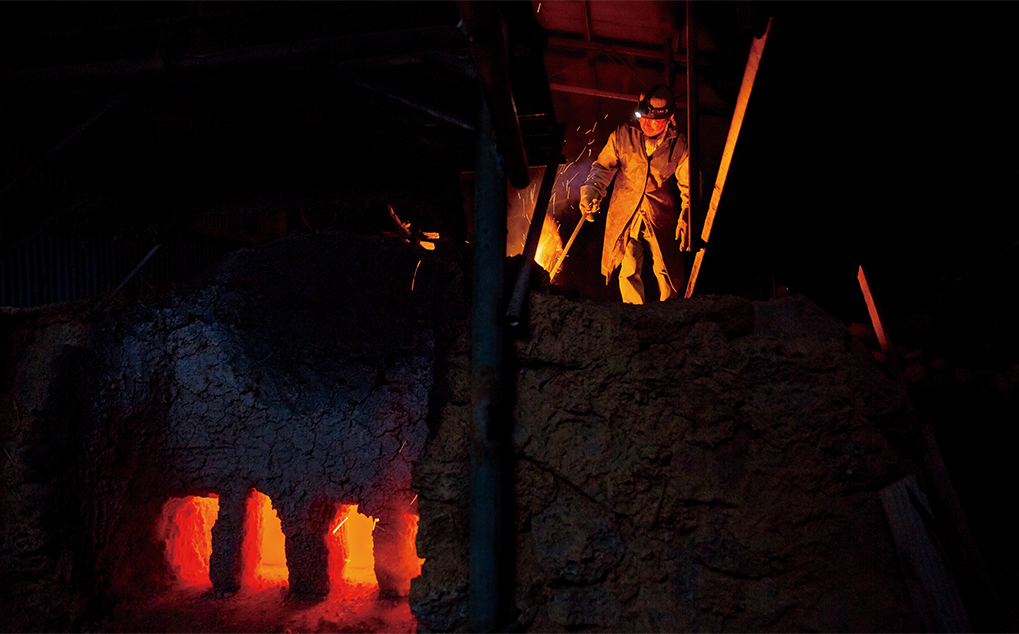
Kang Chang-eon, founder and director of the Jeju Ceramic Center, stokes fire from the top of the yellow kiln. The temperature inside the kiln reaches its peak four days after the fire is lit. This is the final stage when dry firewood is inserted through holes on the sides of the kiln to build up the fire while the vessels acquire a glossy shine on the surface as if glazed.
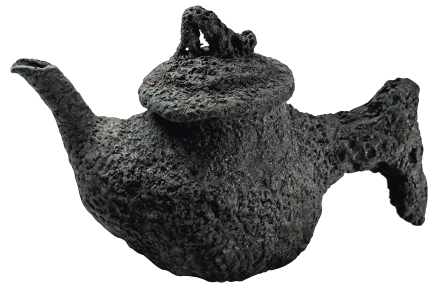
“Gahina Tea Pottery,” 7.6 x 18.5 cm.
Produced using a patented method by the Jeju Ceramic Center, the tea pot was awarded the Seal of Excellence for Handicrafts by UNESCO in 2007. It is made from a special type of clay developed by the center to imitate the texture of basalt.
During the Jeju Uprising of April 3, 1948, which was effectively a forewarning of the tragic Korean War, the islanders, even when desperately fleeing from government forces chasing communist guerillas, took their onggi with them. It shows just how indispensable the vessels were in their lives.
The use of the homely and sturdy earthenware has a long history on the island, as testified in historical sources. In a poem titled “Tamna,” Choe Bu (1454-1504), a civil official of the Joseon Dynasty, described a Jeju woman carrying a large pottery jar on her way to a spring to draw water. Choe is the well-known author of “Choe Bu’s Diary: A Record of Drifting across the Sea” (Pyohaerok), a masterpiece of ancient Korean travel literature. The poem is contained in “A Journal from the Southern Island” (Namsa illok), written by Yi Jeung (1628-1686), another Joseon official who served on the island. “Gazettes of Jeju” (Jeju eupji), presumably published in the 18th century, also notes, “There is a store in Daejeong that specializes in onggi pottery.”
The earliest archetypes of Jeju onggi are found in two types of prehistoric vessels, some plain and some with raised patterns, discovered at an archaeological site in Gosan village, located in Hangyeong township. The earthenware is believed to be around 10,000 years old. To date, the undecorated vessels are among the oldest Neolithic pottery discovered in Korea, while those with raised wavy patterns are considered the pinnacle of ancient Jeju pottery.
Onggi production on Jeju reached its peak in the early 20th century, but vanished completely by the late 1960s. With its elaborate production process, onggi could not compete with cheap, mass-produced plastic wares. The person who revived the Jeju onggi tradition was Kang Chang-eon, founder and director of the Jeju Ceramic Center.
Restoration of Traditional Stone Kilns
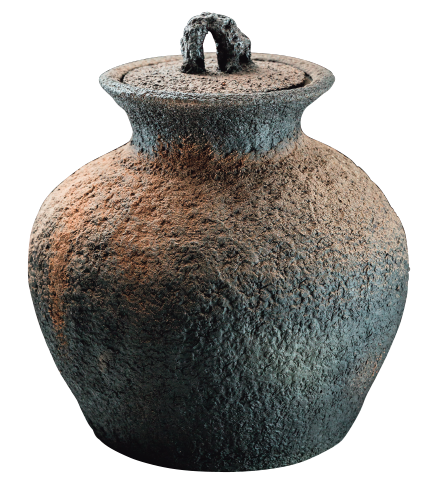
“Stone Jar,” 28 x 22.3 cm.
The jar was formed by paddling the clay on the wheel with a stone, creating a rough texture resembling basalt.
In the 1970s, while still in his youth, Kang began visiting ruined kiln sites, and upon closely examining the onggi fragments, he discovered a unique quality in the traditional earthenware. In the early 1980s, he quit his job to fully devote his time to conducting field studies, traveling countless times to coastal villages and mid-mountainous areas. At that time, around 50 stone kilns remained on the island. Eventually, he joined the Jeju National University Museum and began his studies in earnest, working together with scholars at home and abroad. But as modernization swept the country, the remaining sites began to be severely damaged.
In the early 1990s, experienced onggi potters began to pass away one by one, and with them, the tools they used disappeared. Driven by a sense of urgency, Kang searched for surviving potters, but most had switched to farming as it had become too difficult to earn a living as potters. Kang tried to persuade them to join him in his efforts to revive the Jeju onggi tradition, but at first, none of them would budge.
The restoration of traditional stone kilns was only possible with the help of skilled craftsmen. Fortunately, several surviving artisans, including Hong Tae-gwon and Song Chang-sik, eventually gave him their full support. In 1996, Kang invested his entire fortune to establish the Jeju Ceramic Center in the village of Yeongnak in the town of Daejeong; four years later he began making Jeju-style onggi in the traditional way.
Over a long time, Jeju onggi had evolved differently from similar wares produced on the mainland. The biggest difference would be the method of firing, which takes place in a stone kiln made of basalt rocks instead of an earthen kiln built with clay bricks. This production process is distinctly different from other regions in Korea, as well as China or Japan, and is rarely found in other parts of the world.
Different Production Process
Another distinguishing feature of Jeju onggi is that they are not glazed, mainly because they are made with volcanic ash soil instead of the white or red clay commonly used on the mainland. This method was devised by the islanders who lived in an environment where soil suitable for pottery production was rare. Volcanic ash soil contains many minerals, which melt and ooze to the surface during the firing process, producing the effect of a glossy coating. In addition, unlike in other regions where wood from tree trunks is used to heat the kiln, branches dried in the shade are used as fuel.
The Jeju onggi production process is also distinguished by the division of labor. The vessels are not made by a single potter; each stage of production involves a different specialist: the geonaekkun collects the soil and firewood; the onggi-daejang shapes the vessel; the bul-daejang stokes the fire; and the gul-daejang supervises the entire process. Manufactured in this specialized and collaborative way, Jeju onggi are a product of the local communal culture.
In many respects, conditions on the island were not favorable for pottery production, most of the soil being unsuitable and the water having to be carried in large jars over significant distances. The words of the late potter Shin Chang-hyeon, who held the title of Jeju Intangible Cultural Property No. 14, encapsulate the grueling nature of the task: “Making onggi is an arduous undertaking; it requires trips to and from the netherworld.” The pots and jars laboriously d in such inhospitable conditions have long been an important part of the daily lives of the people of Jeju.
Pottery kilns are called gul in Jeju, which means “cave” in Korean. The semi-cylindrical ceiling, so shaped due to the natural contour of the land, gives the kilns the appearance of a cave. There are two types of kilns: yellow kilns and black kilns, so named because the pots fired in them exhibit yellow and black hues, respectively. The color difference comes from differences in firing temperatures.
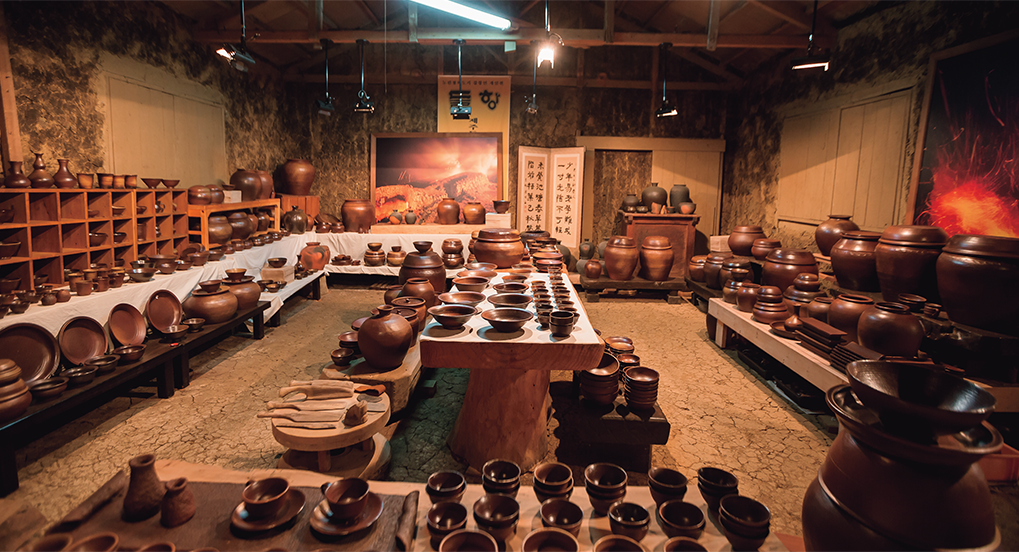
The exhibition room at the Jeju Ceramic Center showcases products of the center. The elaborate process and high costs of production make popularization difficult, but the center attracts pottery enthusiasts from Japan and China.
Kiln Temperatures and Vessel Colors
In the yellow kilns, the temperature is raised up to 1,100 to 1,200 degrees Celsius. During this process, the clay is oxidized, and the surface of the vessel becomes glossy as if glazed and turns yellowish or reddish brown. At such high temperatures, patterns form naturally on the surface, which Kang calls “flame patterns.” These stalwart vessels keep food from going bad, so they are mainly used to hold food or carry water.
The black kilns fire vessels at lower temperatures of around 700 to 900 degrees Celsius. The openings in the front and back of the kilns are blocked to reduce oxygen levels. This results in incomplete combustion and as the smoke permeates the vessels, they turn gray or black. These vessels are used for storing dry foodstuff or steaming food.
At the Jeju Ceramic Center, the yellow and black kilns are restored in the traditional style using basalt. Kang picked out stones of appropriate sizes or trimmed them if needed. The gaps between the stones were filled with basalt fragments or clay.
The biggest difference would be the method of firing, which takes place in a stone kiln made of basalt rocks instead of an earthen kiln built with clay bricks.
The Virtue of Waiting
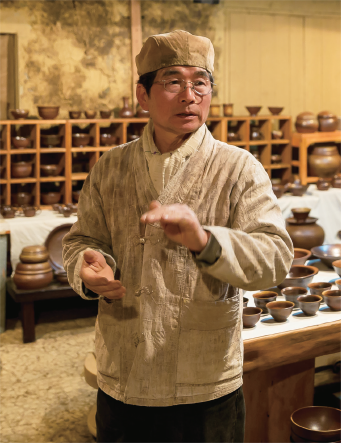
Saddened to see the traditional stone kilns and earthenware of Jeju fading into history, Kang Chang-eon restored the island’s traditional kiln in 2000 after years of painstaking efforts.
The yellow kiln measures 12 meters in length; the space from the fire hole to the smoke outlet is divided into the firing chamber and the combustion chamber. The fire hole is made in the front of the kiln, the lower part coming into contact with the ground. It appears to be arch-shaped but is actually more of a square shape with a ceiling stone placed on top of stone pillars standing on either side. A notable feature of Jeju stone kilns is the significantly narrower fire hole, as seen in discarded kilns from over 100 years ago in Sindo village in western Jeju, as well as those at the Jeju Ceramic Center.
The ceiling’s exterior is covered with sandy soil; on the left and right side are 15 holes, each about 15 centimeters in diameter and placed at regular intervals. These are for checking and feeding the fire. There is no chimney in the back; instead, there are four small holes to let the flames out.
The black kiln is smaller, measuring seven meters in length, and is not divided into separate compartments. The vessels are placed inside or taken out of the kiln through an opening in the back. After they are removed, the opening is blocked by loosely stacking stones rather than sealing.
Another distinctive feature of Jeju’s stone kilns is the area in front of the fire hole, which is enclosed by a low barrier made of basalt. Called bujangjaengi, the area takes its name from the grass that covers it and provides shelter from the elements, especially from the island’s harsh winds.
“Black Earthenware Jar” (front), 41.4 x 33.0 cm; and “Yellow Earthenware Jar,” 37.5 x 29.0 cm.
The black jar has distinct “flame patterns” naturally d during firing. The yellow jar has a lighter shade around its mouth and shoulder, also a natural phenomenon that occurred while firing.
Made with porous volcanic ash soil, Jeju onggi is first formed, then stored in a hut for 10 months before being fired. The hut is also made of basalt, and any gaps are carefully filled with soil to prevent light or air from entering. This is another remarkable feature of Jeju pottery. Like the birth of a new life, it teaches us the virtue of waiting - humbly.